| Srl | Item |
| 1 |
ID:
103520
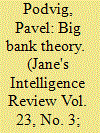

|
|
|
| 2 |
ID:
169455


|
|
|
|
|
| Summary/Abstract |
Nuclear disarmament is often seen as eventually requiring access to nuclear warheads or to the warhead-dismantlement process to verify that a state has not hidden weapons or weapon-materials despite promising to disarm. This article suggests this view is misplaced, and that what is needed is a verification mechanism able to provide reliable assurances of the absence of fissile materials available for use in weapons after a state has disarmed. Such a mechanism will need an initial declaration of the amount of fissile materials held by a state for all purposes, military and civilian. In a state with a nuclear arsenal awaiting elimination, this declaration would have to include materials that may not be available for verification because they are in nuclear weapons or are in other classified or proliferation-sensitive forms. This article describes a verification arrangement that does not require access to materials in weapons and in sensitive forms while still allowing checks on the overall accuracy of the declaration. Verification of the completeness and correctness of the declaration is deferred to the time when the weapons-relevant material enters the disposition process, at which point it no longer has any sensitive attributes. By removing the focus on monitoring warheads and dismantlement, this new approach could provide a more manageable path to nuclear disarmament.
|
|
|
|
|
|
|
|
|
|
|
|
|
|
|
|
| 3 |
ID:
157468
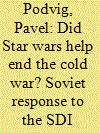

|
|
|
|
|
| Summary/Abstract |
The Strategic Defense Initiative was a U.S. missile defense program that played a very prominent role in the U.S.-Soviet relationships in the 1980s and is often credited with helping end the Cold War, as it presented the Soviet Union with a technological challenge that it could not meet. This article introduces several official Soviet documents to examine Soviet response to SDI. The evidence suggests that although the Soviet Union expressed serious concerns about U.S. missile defense program, SDI was not a decisive factor in advancing arms control negotiations. Instead, the program seriously complicated U.S.-Soviet arms control process. SDI also failed to dissuade the Soviet Union from investing in development of ballistic missiles. The Soviet Union quickly identified ways to avoid a technological arms race with the United States and focused on development of advanced missiles and anti-satellite systems to counter missile defenses. Some of these programs have been preserved to the current day.
|
|
|
|
|
|
|
|
|
|
|
|
|
|
|
|
| 4 |
ID:
104161
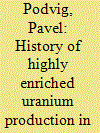

|
|
|
| 5 |
ID:
102383
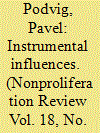

|
|
|
|
|
| Publication |
2011.
|
| Summary/Abstract |
The 2010 Nuclear Posture Review (NPR) conducted by the United States has become an important element of the US-Russian relationship, for the policies set during the review process directly affect Russian officials' perceptions of their security environment and provide a framework for the domestic debate on security issues. From Moscow's point of view, the most important outcome of the NPR process was the resumption of the bilateral arms control negotiations and the US willingness to work with Russia to resolve the dispute about missile defense. These developments helped strengthen the domestic institutions in Russia that support a cooperative US-Russian agenda, securing Russia's cooperation with the United States on a range of nonproliferation issues. Additionally, the renewed US commitment to nuclear nonproliferation, disarmament, and reduced reliance on nuclear weapons has apparently had an effect on the new Russian military doctrine, which somewhat reduces the role of nuclear weapons in Russian national security policy.
|
|
|
|
|
|
|
|
|
|
|
|
|
|
|
|
| 6 |
ID:
091897
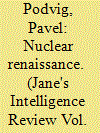

|
|
|
|
|
| Publication |
2009.
|
| Summary/Abstract |
Global nuclear energy production is projected to triple over the next 50 years, raising concerns about the risk of proliferation. Pavel Podvig explores the security challenges associated with nuclear power and considers options for regulating the industry.
|
|
|
|
|
|
|
|
|
|
|
|
|
|
|
|
| 7 |
ID:
075372
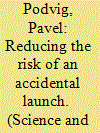

|
|
|
|
|
| Publication |
2006.
|
| Summary/Abstract |
One of the serious risks associated with the strategic nuclear arsenals of Russia and the United States is that an accidental launch might result from a false alarm or from misinterpreting information provided by an early-warning system. This risk will not be reduced by bringing down the number of strategic missiles on high alert to the level of about 500 warheads on each side because this measure will not significantly affect first-strike vulnerability of the Russian strategic forces. Other measures that have been suggested so far, namely an upgrade of the Russian early-warning system, establishing additional channels of real-time exchange of early-warning data, or transparent and verifiable de-alerting of strategic forces, are more likely to increase the probability of an accident than to reduce it. To address the problem of an accidental launch in the short term, the United States and Russia, while continuing to work toward deep reductions of their strategic nuclear forces, should develop and implement measures that would keep their entire forces at low levels of readiness without revealing their actual alert status.
|
|
|
|
|
|
|
|
|
|
|
|
|
|
|
|
| 8 |
ID:
050803
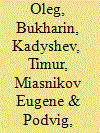

|
|
|
|
|
| Publication |
Cambridge, MIT Press, 2001.
|
| Description |
xxi, 692 p.
|
| Standard Number |
0262162024
|
|
|
|
|
|
|
|
|
|
|
|
Copies: C:1/I:0,R:0,Q:0
Circulation
| Accession# | Call# | Current Location | Status | Policy | Location |
| 047876 | 355.02170947/OLE 047876 | Main | On Shelf | General | |
|
|
|
|
| 9 |
ID:
096436


|
|
|
| 10 |
ID:
083096


|
|
|
|
|
| Publication |
2008.
|
| Summary/Abstract |
The Soviet strategic modernization program of the 1970s was one of the most consequential developments of the Cold War. Deployment of new intercontinental ballistic missiles and the dramatic increase in the number of strategic warheads in the Soviet arsenal created a sense of vulnerability in the United States that was, to a large degree, responsible for the U.S. military buildup of the late 1970s and early 1980s and the escalation of Cold War tensions during that period. U.S. assessments concluded that the Soviet Union was seeking to achieve a capability to fight and win a nuclear war. Estimates of missile accuracy and silo hardness provided by the U.S. intelligence community led many in the United States to conclude that the Soviet Union was building a strategic missile force capable of destroying most U.S. missiles in a counterforce strike and of surviving a subsequent nuclear exchange. Soviet archival documents that have recently become available demonstrate that this conclusion was wrong. The U.S. estimates substantially overestimated the accuracy of the Soviet Union's missiles and the degree of silo reinforcement. As the data demonstrate, the Soviet missile force did not have the capability to launch a successful first strike. Moreover, the data strongly suggest that the Soviet Union never attempted to acquire a first-strike capability, concentrating instead on strategies based on retaliation
|
|
|
|
|
|
|
|
|
|
|
|
|
|
|
|